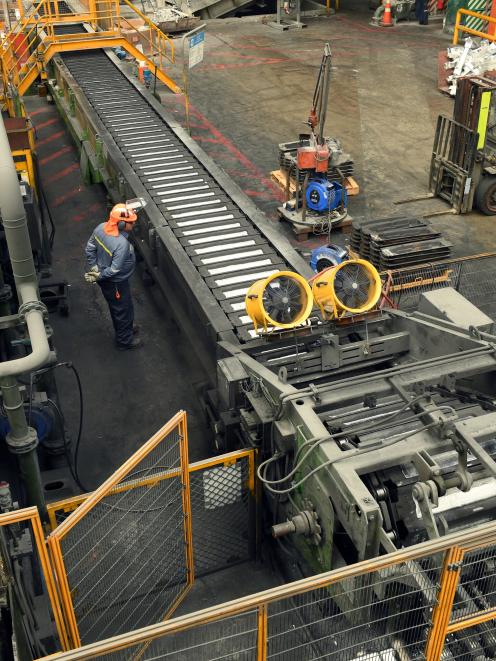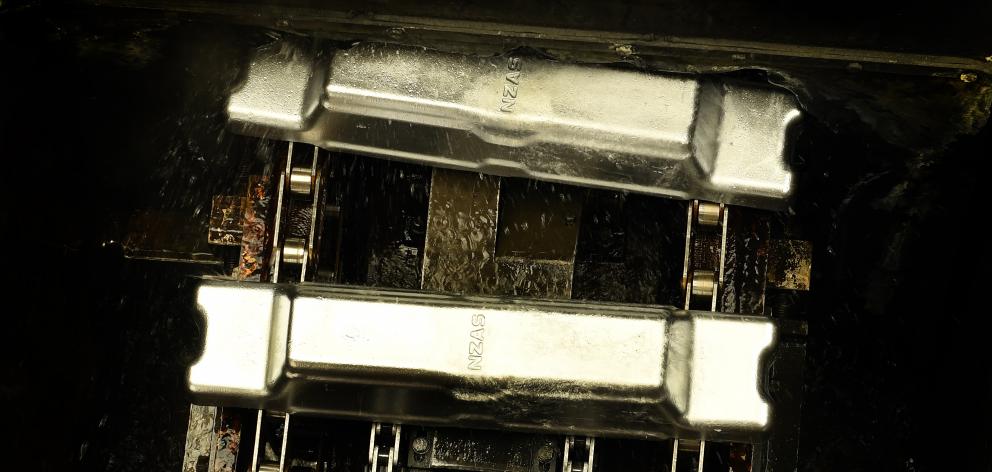
Gretta Stephens undoubtedly knows her knitting.
The boss of the Tiwai Point aluminium smelter is an intriguing mix; undeniably smart with an evident passion for a challenging industry.
She is also warm and engaging and likes nothing better than whipping out her knitting needles while flying to a big board meeting in Japan. It is a hobby, she acknowledges, some people struggle to picture her doing.
And she humorously quips the nice thing about being a woman working in heavy industry is "absolutely no expectation of hair and make-up".
Mrs Stephens (50) became general manager in August 2013, the first woman to be appointed to the role. It’s a big gig. Tiwai’s challenging times — and threats of closure — have been well documented, as have its massive contribution to the Southland economy with NZAS estimated to contribute $525 million, or 10.5%, to the region’s GDP.
When she first became general manager, Mrs Stephens admitted returning the plant to financial viability would be a challenge but she was excited and enthusiastic about the task.
Four and-half years later, that enthusiasm was undimmed as she acknowledged the weight of responsibility she felt most predominantly was a responsibility to maintain the smelter as a thriving business for the people that worked there, the community that surrounded it, and New Zealand as a whole.
Asked how Tiwai was going, Mrs Stephens said it was better than it had been in about five years.
Most commodity businesses went into a very big slump after the global financial crisis. In 2012-13, Tiwai lost money and it had been climbing back from that since then. It had been "in the black" from 2014.

By no means was the Tiwai team "feeling all comfortable"; the business was "exquisitely sensitive" to the exchange rate and that could continue to move.
Tiwai was a very good place to make aluminium at a low dollar but it was expensive when it was high.
In the years when Tiwai had not made a profit, the only people who had not been paid were its owners, yet the community and New Zealand still benefited, she said.

Mrs Stephens has a long association with NZAS and Southland, dating back decades before she took on her current role.
She lived in Invercargill and worked at NZAS from 1993 to 1998 and was a regular visitor to the site from then until 2005, and again since rejoining Rio Tinto Alcan in 2010.
Australian-born — "I’ll never get rid of this accent" — but with a desire to gain Kiwi citizenship soon — she grew up in Melbourne.
She was "always a bit on the brainy side"; a straight-A student studying mathematics and science through secondary school.
"If you had asked me when I was about 7 years old, I would have said I wanted to be a research scientist," she said.
When it came to tertiary study, she had only ever thought about science — engineering had never been presented as an opportunity. On reflection, that was probably a gender thing, she said.
About halfway through completing a bachelor of science degree, in chemistry and materials science, at Monash University, it dawned on her that being a research scientist was going to revolve around being in a white coat and working in a laboratory.
Some of her male friends were studying engineering and she thought it looked a lot of fun, so she applied to do a double degree, completing a bachelor of engineering alongside the science degree, which she thought she might as well finish.

She advanced through roles in technical development, technical operations management then into operations leadership at superintendent and manager level before progressing to a corporate general manager role, then general manager operations.
She has worked at three aluminium smelters, for two aluminium companies (Comalco/Rio Tinto Alcan/Pacific Aluminium and Alcoa) with exposure to a variety of aluminium smelting operations across the world, conducting improvement work and technical audits at smelters in Australia, New Zealand, Dubai, Brazil, Canada, France and the United States.
Before becoming general manager role at Tiwai, Mrs Stephens was general manager of business improvement and technology for Pacific Aluminium’s four aluminium smelters across Australia and New Zealand.
As a young engineer, the job involved lots of travel. In 1993, a project she had been working on reached commercialisation stage, with trials in smelters, and she came to Tiwai for a six-month secondment. Not only did she enjoy her time there, but she also became rather fond of an engineer who was later to become her husband.
"It’s a Tiwai romance," she quips.
When the secondment ended, she returned to Australia, as she had agreed to be bridesmaid at a friend’s wedding, but she organised a permanent job for herself at Tiwai before she left. She returned around mid-1994 and stayed until 1998. It was during that time she felt her biological clock starting to tick, despite having never been particularly maternal.
Turning 30 coincided with a desire for a baby and she and husband Robert decided to start a family.
But some of the roles on-site were not considered advisable while pregnant, and she realised that she would not be able to continue the job she was in.
She returned to the research centre in Melbourne, where she had previously worked, and stayed there during the time she had both her two children, now aged 19 and 16.

Tiwai, Invercargill and the Southland region had now been a big part of Mrs Stephens’ life for more than 20 years.
Had the young engineer been asked in the early 1990s what her dream job was, it would probably be the role she was in now, she said.
"It’s so busy, it’s interesting. We are never bored, we are frequently laughing. It’s not without its challenges — we often say, if this was easy ... they wouldn’t need us," she said.
Mrs Stephens loved the technical side of the role, but also thrived on the people side.
Describing herself as quite extroverted, she loved the work she did in community and external relations, whether that was with customers, suppliers or Government regulators.
"We have a real opportunity to help people understand who and what this place is. What we do here is so interesting and so cool [and there is] so many fabulous, passionate, talented people coming together to do it."
Tiwai has about 800 staff, made up of about 650 employees and 150 contractors, and the site operates 24/7.
Mrs Stephens started each day with a "toolbox meeting", otherwise known as a start of shift meeting.
There were about 48 of them on-site and it took her three months to do a complete lap to every meeting.
That ensured she was close to any day-to-day issues on the site, and also provided valuable staff interaction.
Being such a big site, she often recognised staff from their walk, she laughed, something that was quite helpful, as they looked different off-site and without their safety apparel.
Her day’s work was then varied — it could include normal operational-type meetings, external relations, cost control, safety management — which was an "absolutely massive" part of the role — hosting visitors, reviewing improvement projects, or tackling big annual things like financial performance.
There was a big board meeting in Southland and another in Japan each year. The company also had its own superannuation fund, of which she was chairwoman. "My calendar doesn’t have many open slots in it," she acknowledged.
Outside of work, but still technically with her "work hat on", she was on the Southland Chamber of Commerce, which provided a good connection with the local business community.
She served on the governance committee for the Southland Regional Development Strategy which was launched in 2016.
More recently, she was named on the board for the New Zealand Business and Parliament Trust, a not-for-profit education trust that aimed to advance and encourage business understanding of Parliament and parliamentarians’ understanding of the business community.
That mutual understanding between Government and business was essential.
"We need to understand why things go the way they do, they need to understand the impact of ... policies on business," she said.
She was learning Te Reo at the Southern Institute of Technology and endeavoured to stay fit, swapping cycling for walking and tramping.
As far as future career plans, Mrs Stephens said she was not actively looking for her next change.
But shoulder-tapping did happen and she kept an open mind. She loved the peace of New Zealand and wanted to eventually retire here.
Gender diversity was something that she felt strongly about and that started with recruitment. There were not a lot of applications from women for jobs at Tiwai.
There was an external perception that heavy industry was something that men did and work needed to be done on changing that.
Working at Tiwai was not about "swinging heavy sledgehammers". Much of the work now was with a remote control.
"It’s quite achievable. You don’t have to be built like a front-rower to work here," she said.
Tiwai’s apprentice intake had just been increased for the first time in a few years, it brought in about 30 university students in the holidays and also offered tertiary scholarships.
NZAS was a headline sponsor for the local Southland science and technology fair and, for 10 years, it had run a partnership with Southland Girls’ High School, bringing final-year physics pupils on-site for projects. It had proved very successful and enrolments in senior physics had more than doubled.
Rather than outwardly preaching that girls could do anything, it was more about "quietly going about your business and being seen to do so".
"I love that phrase, if you can see it, you can be it."
At a glance
• New Zealand’s Aluminium Smelter (NZAS ) is New Zealand’s only aluminium smelter.
• Located on the Tiwai Peninsula in Southland.
• NZAS is 79.36% owned by Pacific Aluminium and 20.64% owned by Japan’s Sumitomo Chemical Company Ltd.
• Pacific Aluminium is a wholly-owned subsidiary of Rio Tinto.
• NZAS produced 337,016 tonnes of saleable aluminium last year.
• 58% of its metal went to Japan, with 11% to the New Zealand domestic market
• It is the largest energy user in the country.












